
Alectryon excelsus, commonly known as tītoki, is a shiny-leaved tree native to New Zealand. It is in the family Sapindaceae. It lives in coastal and lowland forests throughout most of the North Island and from Banks Peninsula to central Westland in the South Island.

Alectryon is a genus of about 30 species of trees and shrubs from the family Sapindaceae. They grow naturally across Australasia, Papuasia, Melanesia, western Polynesia, east Malesia and Southeast Asia, including across mainland Australia, especially diverse in eastern Queensland and New South Wales, the Torres Strait Islands, New Guinea, the Solomon Islands, New Caledonia, New Zealand, Vanuatu, Fiji, Samoa, Hawaii, Indonesia and the Philippines. They grow in a wide variety of natural habitats, from rainforests, gallery forests and coastal forests to arid savannas and heaths.
Wild quince may refer to one of several plant species:
Alectryon repandodentatus is a species of plant in the family Sapindaceae. It is found in Australia and Papua New Guinea.
Sahulana is a genus of butterflies in the family Lycaenidae erected by Toshiya Hirowatari in 1992. It is monotypic, containing only the species Sahulana scintillata, which was first described by Thomas Pennington Lucas in 1889. It is found on Torres Strait Island and in the Australian state of New South Wales. Larval food plants include Acacia, Alectryon and Cupaniopsis.

Backhousia subargentea is a rare Australian rainforest tree, growing near Mullumbimby in north eastern New South Wales and from Boonah to Imbil in south eastern Queensland.

Alectryon tomentosus, commonly known as the hairy birds eye, red jacket or woolly rambutan, is a rainforest tree of the family Sapindaceae found in eastern Australia. The specific epithet tomentosus refers to the hairy leaves and hairy young shoots.
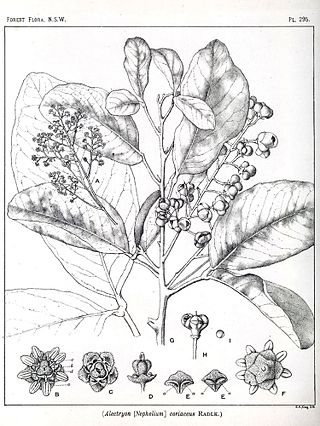
Alectryon coriaceus, known as the beach bird's eye, or beach alectryon is a rainforest tree of the soapberry family found in eastern Australia. The specific epithet coriaceus refers to the leathery thick leaves. Leaflets are 4 to 12 cm long, and 2 to 7 cm wide.

Candalides absimilis, the pencilled blue or common pencil-blue, is a species of butterfly of the family Lycaenidae. It is found along the east coast of Australia, including Queensland, the Australian Capital Territory, New South Wales and Victoria.

Casuarina cristata, commonly known as belah or muurrgu, is a species of flowering plant in the family Casuarinaceae and is endemic to inland eastern Australia. It is a tree with fissured or scaly bark, sometimes drooping branchlets, the leaves reduced to scales in whorls of 8 to 12, the fruit 13–18 mm (0.51–0.71 in) long containing winged seeds (samaras) 6.0–10.5 mm (0.24–0.41 in) long.

Acacia loderi, known colloquially as nelia or nealie, is a species of Acacia native to Australia.
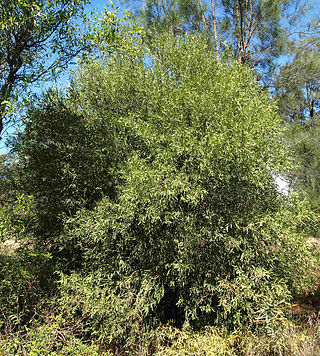
Alectryon oleifolius, commonly known as boonaree, inland rosewood or bullock bush, is a species of small tree of the soapberry family Sapindaceae, native to Australia.
Aenetus ramsayi, the swift ghost moth, is a moth of the family Hepialidae. It is known from Queensland and New South Wales.

The Brunswick Heads Nature Reserve is a protected nature reserve located in the Northern Rivers region of New South Wales, Australia. The 221-hectare (550-acre) reserve is situated near Brunswick Heads and contains an intact segment of littoral rainforest. Situated between Brunswick Heads and Ocean Shores townships, it offers a variety of tourism activities. It is popular for school excursions, offers fishing, bird watching, cycling, nature walking, canoeing and picnicing.
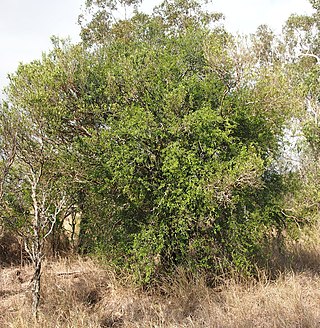
Alectryon diversifolius, commonly named scrub boonaree or holly bush, is a species of Australian small trees of the plant family Sapindaceae.
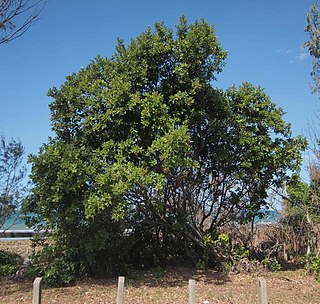
Alectryon connatus, sometimes named hairy alectryon, is a species of small trees, constituting part of the plant family Sapindaceae.

The Cumberland Plain Woodland, also known as Cumberland Plain Bushland and Western Sydney woodland, is a grassy woodland community found predominantly in Western Sydney, New South Wales, Australia, that comprises an open tree canopy, a groundcover with grasses and herbs, usually with layers of shrubs and/or small trees.
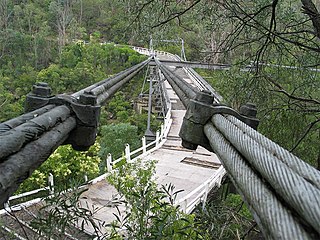
The Western Sydney Dry Rainforest and Moist Woodland is a dry rainforest found in small pockets in south-western Sydney, New South Wales, Australia. Mostly featuring sclerophyll vegetation, it is listed as critically endangered under Australia's national environment law, the Environment Protection and Biodiversity Conservation Act 1999 as more than 70 per cent of its original extent has been reduced as a result of clearing, logging, weed invasion and heavy grazing.

The Illawarra-Shoalhaven subtropical rainforest, or Illawarra Subtropical Rainforest (ISR), is a scattered rainforest community in the Illawarra region of New South Wales, Australia. Occurring just south of Sydney, it spans from the Royal National Park (north of Wollongong) to the Milton-Ulladulla district in the south, albeit in scattered fragments.















